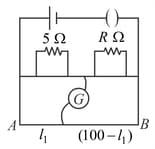Meter Bridge
Meter Bridge: Overview
This Topic covers sub-topics such as Meter Bridge, Post Office Box, Sensitivity of Post Office Box Experiment and, Sensitivity of Meter Bridge Experiment
Important Questions on Meter Bridge
In a meter bridge balance point is found at a distance with resistances R and S as shown in the figure.
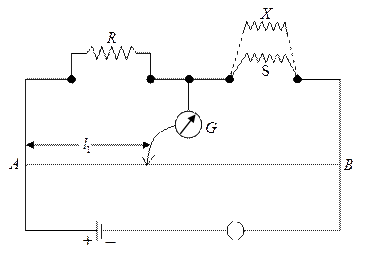
When an unknown resistance X is connected in parallel with the resistance S, the balance point shifts to a distance . Find the expression for X in terms of , and S.
In a meter bridge experiment, resistances are connected as shown in figure. The balancing length . Now, an unknown resistance is connected in series with and the new balancing length is found to be . The value of is (Given, )
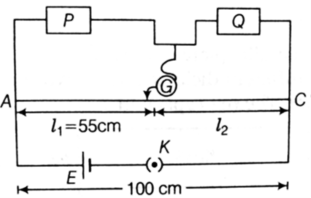
Statement 1 : In post-office box experiment, the battery key is pressed before the galvanometer key.
Statement 2 : In post-office box experiment, if galvanometer key is pressed first and then we press battery key, then galvanometer may get damage.
On interchanging the resistances, the balance point of a meter bridge shifts to the left by 10 cm. The resistance of their series combination is . How much was the resistance on the left slot before interchanging the resistances?
In a meter Bridge experiment resistance is connected in the right gap. When and are connected in the left gap separately the balance points are and respectively from the left end. Now if both are connected in series in the left gap with in the right gap the new balance point from the left end (in ) is , what is the value of ?
The circuit diagram given in the figure shows the experimental setup for the measurement of unknown resistance by using a meter bridge. The wire connected between the points has non-uniform resistance such that resistance per unit length varies directly as the distance from the point Null point is obtained with the jockey with and in the given position. On interchanging the positions and in the gaps the jockey has to be displaced through a distance from the previous position along the wire to establish the null point. If the ratio of find the value of (in ). Ignore any end corrections. [Take ]
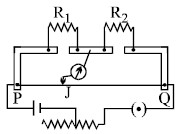
In the given meterbridge, is a wire of uniform cross-section and its resistivity changing from to as . If deflection in galvanometer is zero at such that , the value of is.
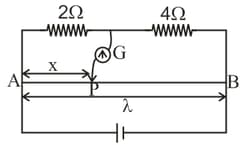
Figure shows a Meter bridge wire has uniform cross-section. The length of wire is is a standard resistor of and is a coil. When is immersed in melting ice the null point is at from point . When the coil is heated to a resistor has to beconnected in parallel with in order to keep the bridge balanced at the same point. The temperature coefficient of resistance of the coil is units. Find the value of .
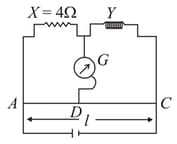
Consider the meter bridge circuit without neglecting end corrections. If we used and resistance in place of and respectively, we get null deflection at . If we interchange the resistances, the null deflection was found to be at . If and are the end correction, then the value of should be
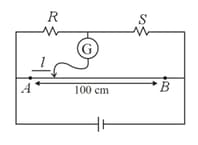
If the wire in the experiment to determine the resistivity of a material using metre bridge is replaced by copper or hollow wire the balance point i.e. null point shifts to
Null method is superior over deflection method because
Where do we get the balancing point of the meter bridge generally?
In a practical meter bridge circuit as shown, when one more resistance of is connected in parallel with unknown resistance , then ratio become . is balancing length. is a uniform wire. Then value of must be:
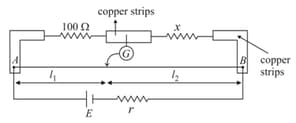
Two resistances and in the two gaps of a meter-bridge gives a null point dividing the wire in the ratio . If each resistance is increased by , the null point divides the wire in the ratio , choose the correct value of and .
Where do we get the balancing point of the meter bridge generally?
With resistance and in the left and the right gap respectively of a meter bridge, the null point divides the wire in the ratio . When and are increased by each, the mull point divides the wire in the ratio . Then the values of respectively are ___.____
A meter bridge is set up as shown to determine an unknown resistance using a standard resistance The galvanometer shows null point when tapping jockey is at mark. The end corrections are as
respectively for the ends and . The determine value of is
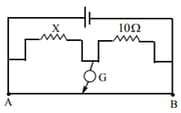
In a meter bridge (as shown below), the null point is found at a distance of from If now a resistance of is connected in parallel with the null point occurs at from Determine the value of (in )
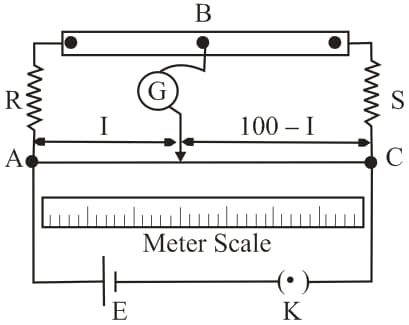
Shown in the given figure, is a metre-bridge set up with null deflection in the galvanometer. The value of the unknown resistor is:
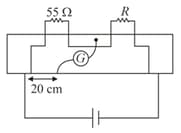
The resistance in the two arms of a meter bridge are and respectively. When the resistance is shunted with an equal resistance, the new balance point is at . The resistance is:
